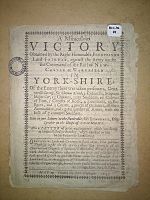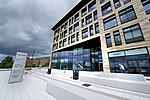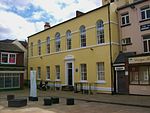Wakefield Exchange

Wakefield Exchange is a public building in the city centre of Wakefield, in West Yorkshire, in England. The building was designed to serve as Wakefield Market Hall, replacing an older market hall on the site. It was designed by David Adjaye and completed in May 2008. It is supported by glulam columns and beams, clad in cedar wood which has been stained grey, with many walls being of glass. Inside, there were three halls, housing about 50 stalls.The new market did not prove successful, and in 2014, Wakefield Council made plans to demolish much of the structure. In 2018, the market closed, and the council proposed to retain only the canopy, and replace it with restaurants and a cinema. However, in 2023, it decided instead to retain the building and convert it into the Wakefield Exchange, an events venue with restaurants, a brewery, and space for creative businesses.
Excerpt from the Wikipedia article Wakefield Exchange (License: CC BY-SA 3.0, Authors, Images).Wakefield Exchange
Union Street, Wakefield Eastmoor
Geographical coordinates (GPS) Address Nearby Places Show on map
Geographical coordinates (GPS)
| Latitude | Longitude |
|---|---|
| N 53.6848 ° | E -1.4977 ° |
Address
WX
Union Street
WF1 3AW Wakefield, Eastmoor
England, United Kingdom
Open on Google Maps











